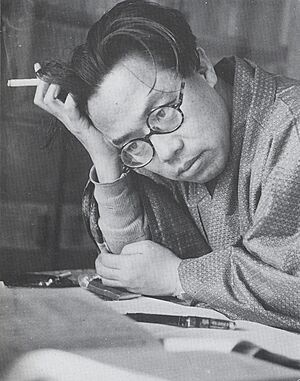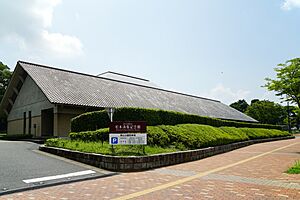Seichō Matsumoto facts for kids
Quick facts for kids
Seichō Matsumoto
|
|
|---|---|

Seichō Matsumoto in 1955
|
|
| Born | Kiyoharu Matsumoto December 21, 1909 Fukuoka, Japan |
| Died | August 4, 1992 (aged 82) Tokyo Women's Medical University Hospital |
| Occupation | Writer |
| Nationality | Japanese |
| Genre | Detective fiction non-fiction Ancient history |
Seichō Matsumoto (松本 清張, Matsumoto Seichō, December 21, 1909 – August 4, 1992; born Kiyoharu Matsumoto) was a famous Japanese writer. He is known for making detective fiction very popular in Japan.
Matsumoto's stories were special because they looked into how people think. They also showed how everyday life and society changed after World War II. He wrote about corruption among police and criminals. His books explored not just the crime, but also how society was affected.
Even though Matsumoto taught himself, he became a very successful author. He published his first book when he was in his forties. Over the next 40 years, he wrote more than 450 books! He wrote historical novels and non-fiction, but his mystery and detective stories made him famous worldwide.
Matsumoto helped many people in Japan enjoy reading detective stories. In the 1960s, he became Japan's best-selling and highest-earning author. Some of his most famous detective novels include Ten to sen (Points and Lines) and Suna no utsuwa (Inspector Imanishi Investigates). These books have been translated into many languages, including English.
He won several important awards for his writing. These include the Akutagawa Prize in 1952 and the Mystery Writers of Japan Award in 1957. He was also the president of the Mystery Writers of Japan from 1963 to 1971. Matsumoto also worked with film director Yoshitarō Nomura to turn eight of his novels into movies, like Castle of Sand.
Contents
Early Life and Education
Seichō Matsumoto was born in 1909 in Kokura, Japan. This city is now part of Kitakyushu, Fukuoka prefecture. His real name was Kiyoharu Matsumoto. He later chose the pen name Seichō, which is another way to read the characters of his first name. He was an only child.
After finishing elementary school, Seichō started working at a utility company. As an adult, he designed newspaper layouts for the Asahi Shimbun in Kyushu. His work was stopped when he served in World War II. He was a medical corpsman and spent much of the war in Korea. After the war, he returned to the newspaper. In 1950, he moved to the Tokyo office.
Matsumoto did not go to high school or university. However, he was very well-educated because he read a lot. As a teenager, he read books that were not allowed at the time. This made his father angry, and he destroyed Seichō's book collection. Matsumoto then started to study award-winning fiction.
His writing career officially began in 1950. A magazine called Shukan Asahi held a writing contest. He entered his short story "Saigō satsu" (Saigō's Currency) and won third place. Six years later, he left his job at the newspaper to become a full-time writer.
Matsumoto's Writing Style
Matsumoto wrote many short stories and novels at the same time. Sometimes he worked on five novels at once! Many of his crime stories first appeared in magazines. One famous story is "Harikomi" (The Chase). It's about a woman meeting her runaway lover while police are looking for them.
Matsumoto won many awards for his writing. These include the Mystery Writers of Japan Prize and the Kikuchi Kan Prize. In 1952, he won the Akutagawa Prize for "Aru 'Kokura-nikki' den" (The Legend of the Kokura-Diary).
He was also interested in archaeology and ancient history. He shared his ideas about these topics in his stories and essays. His interest included places like Northeast Asia and the Celts.
Global Recognition
In 1977, Matsumoto met the famous mystery writer Ellery Queen in Japan. In 1987, French mystery writers invited him to talk about his ideas on mystery writing in Grenoble.
Seichō Matsumoto passed away from cancer when he was 82 years old.
Awards and Honors
- 1953 – Akutagawa Prize: Aru 'Kokura-nikki' den (The Legend of the Kokura-Diary)
- 1957 – Mystery Writers of Japan Award: Kao (The Face) (short story collection)
- 1967 – Yoshikawa Eiji Prize for Literature
- 1970 – Kikuchi Kan Prize
- 1990 – Asahi Prize
Selected Works
Matsumoto wrote over 450 works. Here are some of his well-known novels and short stories:
Novels
- Points and Lines (Ten to Sen, 1958) (also known as Tokyo Express)
- Zero Focus (Zero no Shōten, 1959)
- Pro Bono (Kiri no Hata, 1961)
- Inspector Imanishi Investigates (Suna no Utsuwa, 1961)
- Black Gospel (Kuroi Fukuin, 1961)
- Castle of Glass (Garasu no Shiro, 1976)
Short Stories
- Saigō's Currency (Saigō satsu, 1951)
- The Legend of the Kokura-Diary (Aru "Kokura-nikki" den, 1952)
- The Face (Kao, 1955)
- The Stakeout (Harikomi, 1955)
- The Demon (Kichiku, 1958)
English Translations
Many of Matsumoto's books have been translated into English. This allows readers around the world to enjoy his stories.
Translated Novels
- Points and Lines (1970)
- Inspector Imanishi Investigates (1989)
- Pro Bono (2012)
- A Quiet Place (2016)
- Point Zero (2024)
- Tokyo Express (2023)
Translated Short Story Collections
- The Voice and Other Stories (includes "The Face," "The Serial," and "The Voice")
Film Adaptations
Several of Matsumoto's novels have been made into movies:
- Points and Lines (1958)
- Zero Focus (1961)
- Kiri no Hata (1965)
- Castle of Sand (1974)
- The Demon (1978)
- Suspicion (1982)
See also
 In Spanish: Seicho Matsumoto para niños
In Spanish: Seicho Matsumoto para niños
- Japanese detective fiction


